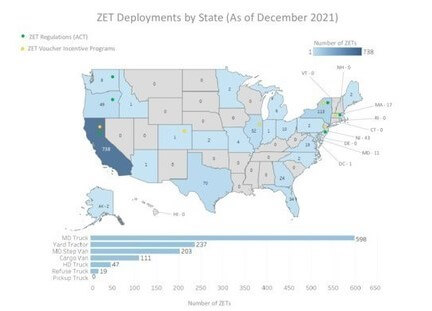CALSTART has published an inventory of Class 2b-8 zero-emission trucks (ZETs) in the U.S., “Zeroing in on Zero-Emission Trucks,” showing that current ZET deployments are concentrated in states that have supportive policies and regulations (California, New York, New Jersey and Illinois) or have received federal funds for ZET purchases (Texas, Oregon, Florida, Georgia, Virginia and Massachusetts).
The report notes that medium-duty trucks, cargo vans, and medium-duty step vans are the most frequent type of ZET deployed, accounting for 75% of vehicles deployed as of 2021.
The report provides insight on ZET market trends as the industry prepares for an injection of federal funding for charging infrastructure, multiple states implement clean truck regulations, and California prepares to release an additional $873 million in purchase incentives for commercial vehicles and infrastructure.
“The actual number of deployed vehicles is still quite low, and we do expect to see shifts in delivery dates and actual delivery of those on order as the market players continue to evolve,” says Kevin Walkowicz, senior director of truck programs at CALSTART. “However, the numbers demonstrate that there is demand that will support significant growth in the industry. CALSTART will continue to track and monitor these developments so the industry and decision-makers have access to the trending numbers.”
Other findings show that the number of available ZET models has increased 625% from 2019. While there are numerous hydrogen fuel cell trucks under development and being demonstrated in the U.S., they are a small percentage of the ZET population. The expected delivery times of the 140,000 ZETs on order are between one and 10 years.
The report is based on data gathered from several sources, including market information providers, incentive program records, public press releases and private correspondence with OEMs. As there is no centralized accounting of ZETs, it is important to note that figures contained in the report should not be considered static nor should any data on ordered vehicles be.
Read the report here.





